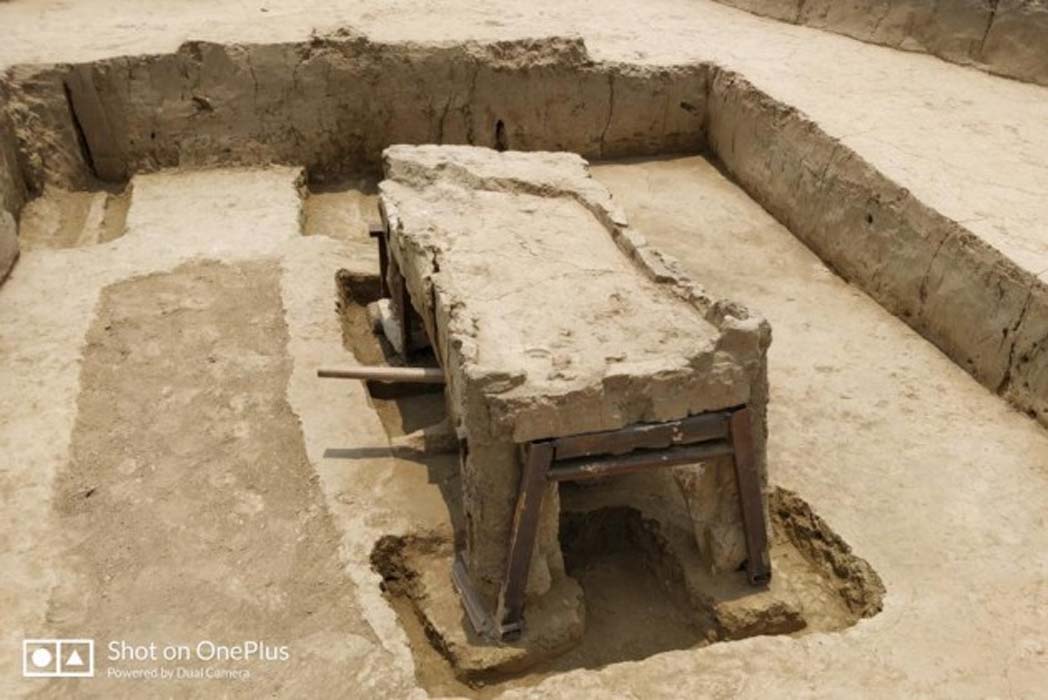23 JUNE, 2018 - 13:53 SACHIN KUMAR TIWARY
Sanauli Find Challenges Aryan Invasion Theory and Could Re-write Indian History
In the month of May 2018 various International and National News channels and Newspapers descended on the village Sanauli to report on a sensational discovery. Chariots and coffins were discovered never before seen on the Indian sub-continent at this time, indicating that a civilization that was previously unknown of existed. Further enquiries could reveal if horses were being used in the area before the Aryan invasion, and whether the current dating of the Mahabharata needs to be revised.
The site of Sanauli is about 60 km (37 miles) from Delhi, (located in theArchaeological Survey of India (ASI) since September 2005 watched over by Dr. D.V. Sharma, the excavation director. Discovery of the site occurred by chance while locals undertook a leveling operation for agricultural purposes. Subsequently, ASI identified the site as a prominent cemetery site of late Harappan period, early 2nd millennium BC or about 5000 years old from before present. The geographical location is quite interesting as the site is located in the confluence of the Yamuna and Hindon rivers and the burials are under flat land, unlike the more usual heaps and mounds.
Finding the Origins of the Site
The site has been studied again in 2018 with Dr. Arwin Manjul as Superintending Archaeologist, Excavation Branch, Purana Quila, New Delhi and Dr. Sanjay Kumar Manjul, Director of the Institute of Archaeology of the Archaeological Society of India.

Dr. Sanjay Kumar Manjul at the Sanauli site pointing out the copper pole of the chariot. ( Outlookindia, Author provided)
The remains of the site correspond to either Mature Harappa or Late Harappan period, but the typical Harappan markers like bronze seals, beads and pottery are not there. This means the remains are neither Indus-Saraswati River Valley Civilization nor any other already assigned period of archaeology, but it doesn’t mean for sure that they are not related to one of these periods. In light of the above, it is interesting as excavators are claiming some of this evidence as from the Vedic period i.e. Mahabharata.
- 2000-Year-Old Bronze Toy Provides Clues on How the Best Roman Chariots Were Constructed to Win Races
- 2400-Year-Old Chariot Dubbed an Ancient Limousine Discovered in Central China
- The True Aryans: Who Were They Really and How Were Their Origins Corrupted?


Royal chariot made from copper. ( via Twitter , Author provided)
Earliest Chariots in India
The excavation unearthed one royal chariot (above) made of copper with solid two wheels, two royal coffin burials with battlefield weapons and other related paraphernalia. The royal coffins are highly decorated with copper plated anthropomorphic figures - having horns, and peepal-leafed. It is the first time this kind of a coffin has been unearthed in the entire sub-continent of India. The sides of the coffins are also decorated with floral motifs. While coffins have already been discovered during past excavations in Harappa, Mohenjo-Daro and Dholavira (Gujarat), these were not laden with such ornamental copper decorations.

General view of the double burial. (Outlookindia, Author provided)
The discovery is reminiscent of a similar sensational discovery by an archaeologist from Peking University, who discovered a group of 30 tombs, 28 chariots and 49 pairs of horse skeletons dating back 2,800 years in Zaoyang city, Hubei Province in China. The present discovery is earlier than the Chinese discovery.Significance of the Finds
This represents a milestone for archaeologists in the region, as for the first time ASI has discovered a burial site including chariots. The discovery of two chariots was significant because it is the earliest such finding in the Indian subcontinent, dating back 3,800 years to 2000-1800 BC which makes it before the Aryan migration it argued to have taken place in around 1500 BC. The finds indicate that the Aryan invaders were not necessarily the first to bring chariots and horses to the region. This points to a different kind of civilization being in existence before the Aryans arrived, one which had its own warrior class. The Harappans were previously thought to be a peaceful people, with the Aryans having the advantage of horses and chariots aiding their easy victory. The truth of this is now in question.
“This is giving our history and our past a new dimension – we have to rethink our past and approach it with a fresh perspective – with the elements found in the burial pits it shows we were a warrior clan in the Pre-Iron Age,” commented Dr Manjul as reported by Manglish Movies .
One of the chariots had two wheels decorated with triangles, suggestive of the sun. In the center of the chariot were four copper tubes into which wooden poles – now decomposed – were inserted to hold the roof. An axle and a yoke were also found. The chariot is similar to those from Mesopotamia. Now there are questions coming out regarding its possible relation with the Mahabharata so influencing beliefs about the timeline for when the various writings contributing to Mahabharata were written, though this is still an enigma.

No comments:
Post a Comment